Submitted:
02 August 2024
Posted:
02 August 2024
You are already at the latest version
Abstract
Keywords:
1. Introduction
2. Literatur Review
Customer Experience Subscription Video on Demand (Svod)
3. Research Methods
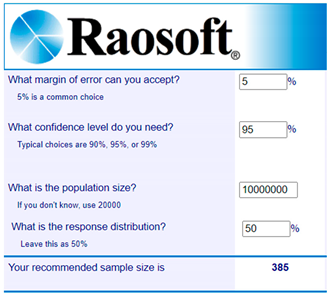
| Author | Title | Research Method | Result |
| Se Ran Yoo, Suk Won Lee & Hyeon Mo Jeon (2020) | The Role of Customer Experience, Food Healthiness, and Value for Revisit Intention in GROCERANT | Quantitative Research Methods with Frequency Analysis | Hedonistic and utilitarian ideals were found to be associated with food health and shopping experiences. It was demonstrated that these values significantly impacted the intention to return. This study deviated from earlier customer experience surveys conducted in the food service sector, which downplayed the significance of food safety. The research model that was given demonstrated the significance of food health as well as the role of the five strategic experience modules in improving consumers' opinions of value and plans to visit a grocery store again. |
| Miguel Ángel Moliner, Diego Monferrer, Marta Estrada & Rosa M. Rodríguez (2019) | Environmental Sustainability and the Hospitality Customer Experience: A Study in Tourist Accommodation | Quantitative Methods | It was evident that there was a connection between environmental sustainability and guest satisfaction in the hotel sector. This study validated the assessment scale based on the parts of the construct that are most often recognized: cognitive (thinking), affective (feeling), behavioral (doing), sensory (feeling), and social (relating). |
| Lova Rajaobelina (2018) | The Impact of Customer Experience on Relationship Quality with Travel Agencies in a Multichannel Environment | Quantitative Research Methods | The findings demonstrated that The aspects of THINK and FEEL were significant factors that improved the quality of relationships. It was also discovered that the SENSE (online) and ACT (in-store) dimensions had a beneficial impact on relationship quality. |
| Shin’ya Nagasawa (2008) | Customer experience managementInfluencing on human Kansei to management of technology | Qualitative Research Methods | From the standpoint of establishing a customer experience, All of the items in the analysis INAX "SATIS," NISSAN "X-TRAIL," Canvas Bags by "Ichizawa Hampu," and Albirex Niigata—meet rigorous requirements for each of the following values: FEEL, SENSE, THINK, ACT, and RELATE. Put differently, they served as a variety of customer experiences. By employing the MOT strategy, they improved the customer experience in addition to offering practical benefits. |
| Ady Milman, Asli D.A. Tasci (2018) | Exploring the experiential and sociodemographic drivers of satisfaction and loyalty in the theme park context | Quantitative Research Methods | The results showed that if overnight visitors grasped people who connected with the FEEL aspect of experience consumerism and thought their visit was worth the cost were more likely to be happy with it than those who didn't. Furthermore, the length of a visitor's visit to a theme park, the quantity of previous excursions, and the quality of their FEEL experience were significant predictors of the likelihood of their return (loyalty). |
4. Result
4.1. Respondent Profile
| Gender | Man Woman |
169 (40%) 254 (60%) |
| Age | 10 to 19 years old 20 to 44 years old 45 to 70 years old |
34 (8%) 380 (89%) 9 (2%) |
| Ocupation | Students/students Official Entrepreneurial Housewives |
196 (46%) 197 (47%) 25 (6%) 5 (1%) |
| Region | Jakarta Bandung Semarang Surabaya Makassar |
148 (35%) 68 (16%) 42 (10%) 131 (31%) 34 (8%) |
| Subscribed SvoD | Netflix WeTV Viu HBO GO Disney+ Hotstar Vision+ |
97 (23%) 34 (8%) 47 (11%) 13 (3%) 148 (35%) 84 (20%) |
| Viewing frequency in 1 month | Under 15 hour Between 16 to 30 hour Between 31 to 45 hour More than 45 hour |
110 (26%) 216 (51%) 59 (14%) 38 (9%) |
4.2. Validity Test
| Variable | Item Questionnaire |
R Table | R Calculate | Information |
|---|---|---|---|---|
| Customer Experience (X) | 1 | 0.4226 | 0.744 | VALID |
| 2 | 0.4226 | 0.735 | VALID | |
| 3 | 0.4226 | 0.770 | VALID | |
| 4 | 0.4226 | 0.694 | VALID | |
| 5 | 0.4226 | 0.755 | VALID | |
| 6 | 0.4226 | 0.773 | VALID | |
| 7 | 0.4226 | 0.758 | VALID | |
| 8 | 0.4226 | 0.799 | VALID | |
| 9 | 0.4226 | 0.801 | VALID | |
| 10 | 0.4226 | 0.849 | VALID | |
| 11 | 0.4226 | 0.755 | VALID | |
| 12 | 0.4226 | 0.807 | VALID | |
| 13 | 0.4226 | 0.746 | VALID | |
| 14 | 0.4226 | 0.791 | VALID | |
| 15 | 0.4226 | 0.848 | VALID | |
| 16 | 0.4226 | 0.836 | VALID | |
| 17 | 0.4226 | 0.860 | VALID | |
| 18 | 0.4226 | 0.854 | VALID | |
| 19 | 0.4226 | 0.823 | VALID | |
| 20 | 0.4226 | 0.866 | VALID | |
| 21 | 0.4226 | 0.778 | VALID | |
| Customer Satisfaction (Y) | 22 | 0.4226 | 0.867 | VALID |
| 23 | 0.4226 | 0.908 | VALID | |
| 24 | 0.4226 | 0.860 | VALID |
4.3. Reliability Test
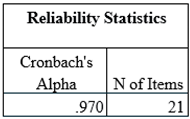

4.4. Normality Test
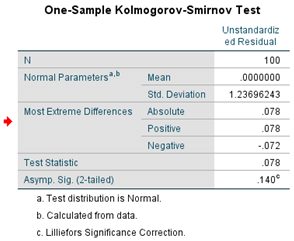
4.5. Multicollinearity Test
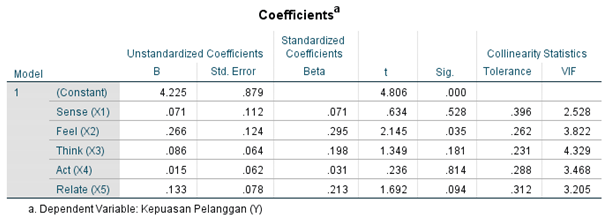
4.6. Heteroskedasticity Test
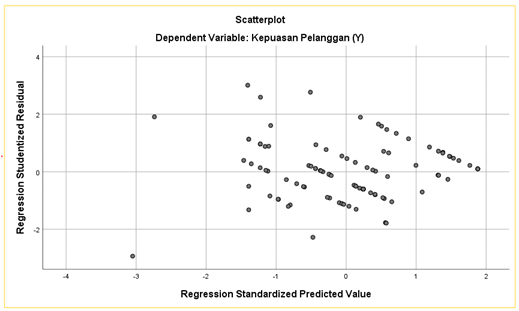
4.7. T-Test
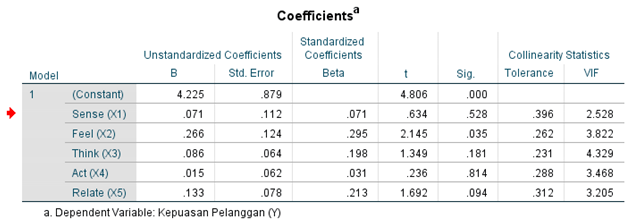
4.8. Determination Coefficient Test

4.9. F Test
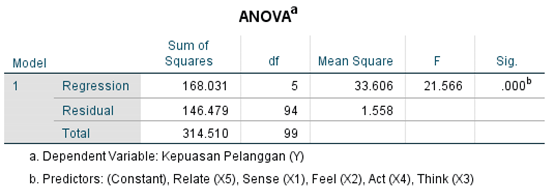
| Variable | Dimension | No | Indicator | Average score |
| Customer Experience (X) | SENSE (X1) | 1 | Ease of transactions. | 3.73 |
| 2 | Attractive application appearance. | 3.98 | ||
| 3 | Feel safe and comfortable. | 4.17 | ||
| FEEL (X2) | 4 | Fast and precise service. | 3.78 | |
| 5 | Provide fast impressions. | 4.03 | ||
| 6 | Transaction fees. | 3.68 | ||
| THINK (X3) | 7 | Website and Social Media information. | 3.88 | |
| 8 | 24 Hour Customer Care Service. | 3.81 | ||
| 9 | Customer Needs. | 3.81 | ||
| 10 | Fast and responsive. | 3.65 | ||
| 11 | Affordable package prices. | 3.76 | ||
| 12 | Provide bundling of certain (special) packages. | 3.97 | ||
| ACT (X4) | 13 | Lifestyle resulting from experiences attached to products. | 4.03 | |
| 14 | Knowledge for customer regarding packages or services. | 3.7 | ||
| 15 | Advertising and Social Media Promotion. | 3.98 | ||
| 16 | Promotion. | 3.72 | ||
| 17 | Discounts or Price Reductions. | 3.36 | ||
| RELATE (X5) | 18 | There is special treatment for regular customer. | 3.72 | |
| 19 | Service Consistency. | 3.96 | ||
| 20 | Cooperation. | 3.98 | ||
| 21 | Partnerships. | 3.8 | ||
| Customer satisfaction (Y) | Customer satisfaction | 22 | Application Usage. | 4 |
| 23 | Feel satisfied and comfortable using the application. | 4.04 | ||
| 24 | Find it easy to use the application. | 4 |
5. Discussion
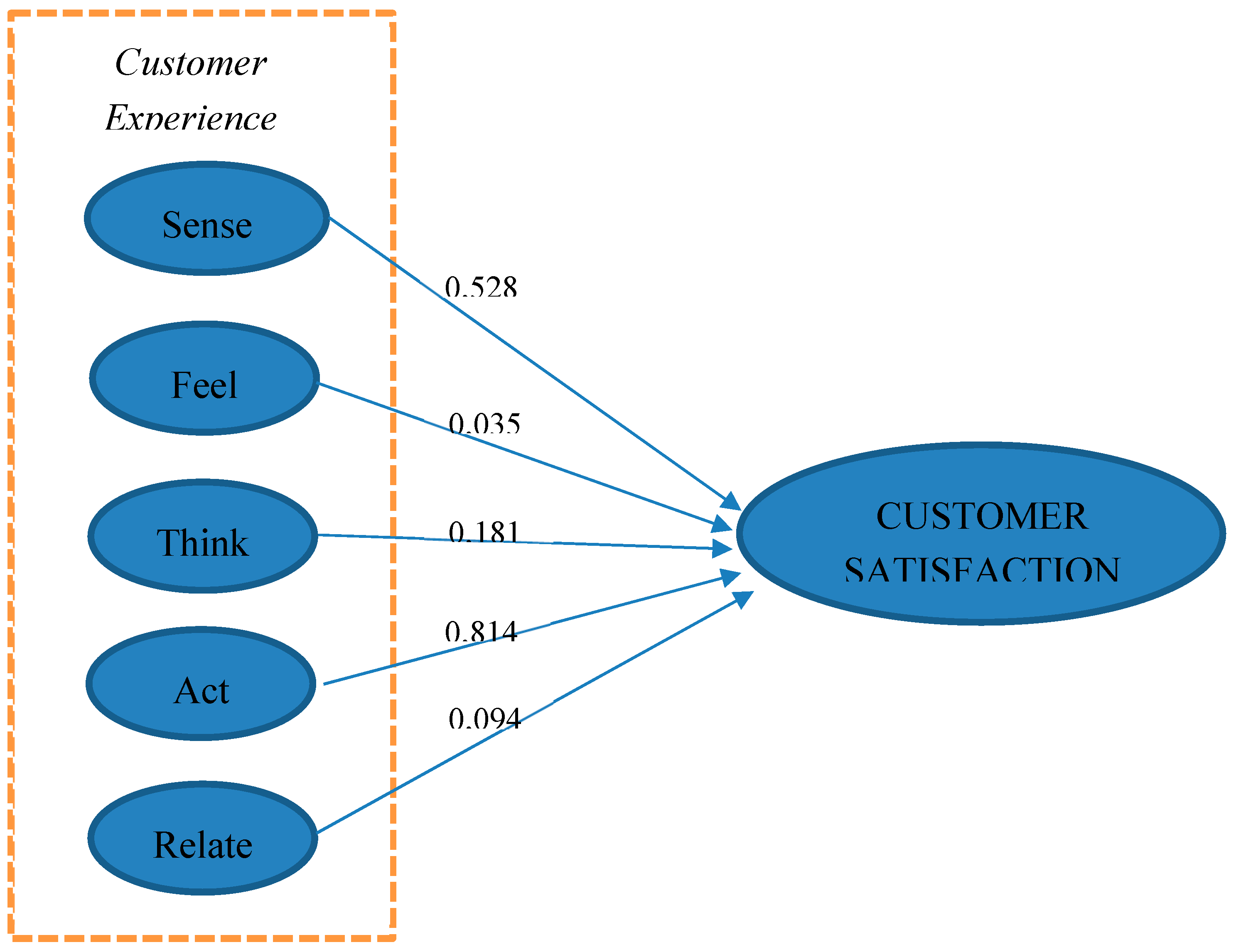
6. Conclusions, Limitation and Future Research
References
- Raats, T.; Evens, T. “If you can’t beat them, be them”: A critical analysis of the local streaming platform and Netflix alternative Streamz. MedieKultur 2021, 37, 50–65. [Google Scholar] [CrossRef]
- Castro, D.; Rigby, J.M.; Cabral, D.; Nisi, V. The binge-watcher’s journey: Investigating motivations, contexts, and affective states surrounding Netflix viewing. Convergence 2021, 27, 3–20. [Google Scholar] [CrossRef]
- Basuki, R.; Tarigan, Z.J.H.; Siagian, H.; Limanta, L.S.; Setiawan, D.; Mochtar, J. The effects of perceived ease of use, usefulness, enjoyment and intention to use online platforms on behavioral intention in online movie watching during the pandemic era. Int. J. Data Netw. Sci. 2022, 6, 253–262. [Google Scholar] [CrossRef]
- Digital TV news Premium video captures 10% of video streaming minutes in SE Asia.
- Dubey, R.; Bryde, D.J.; Blome, C.; Dwivedi, Y.K.; Childe, S.J.; Foropon, C. Alliances and digital transformation are crucial for benefiting from dynamic supply chain capabilities during times of crisis: A multi-method study. Int. J. Prod. Econ. 2024, 269, 109166. [Google Scholar] [CrossRef]
- Verhoef, P.C.; Broekhuizen, T.; Bart, Y.; Bhattacharya, A.; Qi Dong, J.; Fabian, N.; Haenlein, M. Digital transformation: A multidisciplinary reflection and research agenda. J. Bus. Res. 2021, 122, 889–901. [Google Scholar] [CrossRef]
- Gu, S.; Ślusarczyk, B.; Hajizada, S.; Kovalyova, I.; Sakhbieva, A. Impact of the covid-19 pandemic on online consumer purchasing behavior. J. Theor. Appl. Electron. Commer. Res. 2021, 16, 2263–2281. [Google Scholar] [CrossRef]
- Warner, K.S.R.; Wäger, M. Building dynamic capabilities for digital transformation: An ongoing process of strategic renewal. Long Range Plann. 2019, 52, 326–349. [Google Scholar] [CrossRef]
- Carissa, N.E.; Erlangga, M.; Evik, C.S.; Handayani, P.W. The Influence of Perceived Usefulness, Satisfaction, and Personalization on Subscription Video on Demand Continuance Intentions. CommIT J. 2023, 17, 169–184. [Google Scholar] [CrossRef]
- Iglesias, O.; Markovic, S.; Rialp, J. How does sensory brand experience influence brand equity? Considering the roles of customer satisfaction, customer affective commitment, and employee empathy. J. Bus. Res. 2019, 96, 343–354. [Google Scholar] [CrossRef]
- Rita, P.; Oliveira, T.; Farisa, A. The impact of e-service quality and customer satisfaction on customer behavior in online shopping. Heliyon 2019, 5, e02690. [Google Scholar] [CrossRef] [PubMed]
- Sanson, K.; Steirer, G. Hulu, streaming, and the contemporary television ecosystem. Media, Cult. Soc. 2019, 41, 1210–1227. [Google Scholar] [CrossRef]
- Lee, S.; Lee, S.; Joo, H.; Nam, Y. Examining factors influencing early paid over-the-top video streaming market growth: A cross-country empirical study. Sustain. 2021, 13. [Google Scholar] [CrossRef]
- Rios, S.; Scarlata, A. Locating SVOD in Australia and Mexico: Stan and Blim contend with Netflix. Crit. Stud. Telev. 2018, 13, 475–490. [Google Scholar] [CrossRef]
- Baek, H.; Jang, M.; Kim, S. Strategies to mitigate the cannibalization effect between subscription video-on-demand and transactional video-on-demand. Digit. Bus. 2024, 4, 100073. [Google Scholar] [CrossRef]
- Nagasawa, S. Customer experience management: Influencing on human Kansei to management of technology. TQM J. 2008, 20, 312–323. [Google Scholar] [CrossRef]
- Mulla, T. Assessing the factors influencing the adoption of over-the-top streaming platforms: A literature review from 2007 to 2021. Telemat. Informatics 2022, 69, 101797. [Google Scholar] [CrossRef]
- Flavián, C.; Ibáñez-Sánchez, S.; Orús, C. The impact of virtual, augmented and mixed reality technologies on the customer experience. J. Bus. Res. 2019, 100, 547–560. [Google Scholar] [CrossRef]
- Jain, R.; Aagja, J.; Bagdare, S. Customer experience – a review and research agenda. J. Serv. Theory Pract. 2017, 27, 642–662. [Google Scholar] [CrossRef]
- McLean, G.; Al-Nabhani, K.; Wilson, A. Developing a Mobile Applications Customer Experience Model (MACE)- Implications for Retailers. J. Bus. Res. 2018, 85, 325–336. [Google Scholar] [CrossRef]
- Rather, R.A.; Hollebeek, L.D. Customers’ service-related engagement, experience, and behavioral intent: Moderating role of age. J. Retail. Consum. Serv. 2021, 60, 102453. [Google Scholar] [CrossRef]
- Grewal, D.; Levy, M.; Kumar, V. Customer Experience Management in Retailing : An Organizing Framework. 2009, 85, 1–14. [Google Scholar] [CrossRef]
- Ren, L.; Qiu, H.; Wang, P.; Lin, P.M.C. International Journal of Hospitality Management Exploring customer experience with budget hotels : Dimensionality and satisfaction. Int. J. Hosp. Manag. 2016, 52, 13–23. [Google Scholar] [CrossRef]
- Jha, S.; Deitz, G.D.; Babakus, E.; Yavas, U. The Role of Corporate Image for Quality in the Formation of Attitudinal Service Loyalty. J. Serv. Res. 2013, 16, 155–170. [Google Scholar] [CrossRef]
- De Leon, M. V.; Atienza, R.P.; Susilo, D. Influence of self-service technology (SST) service quality dimensions as a second-order factor on perceived value and customer satisfaction in a mobile banking application. Cogent Bus. Manag. 2020, 7. [Google Scholar] [CrossRef]
- Rajaobelina, L. The Impact of Customer Experience on Relationship Quality with Travel Agencies in a Multichannel Environment. J. Travel Res. 2018, 57, 206–217. [Google Scholar] [CrossRef]
- Yoo, S.R.; Lee, S.W.; Jeon, H.M. The role of customer experience, food healthiness, and value for revisit intention in GROCERANT. Sustain. 2020, 12. [Google Scholar] [CrossRef]
- Moliner, M.Á.; Monferrer, D.; Estrada, M.; Rodríguez, R.M. Environmental sustainability and the hospitality customer experience: A study in tourist accommodation. Sustain. 2019, 11. [Google Scholar] [CrossRef]
- Milman, A.; Tasci, A.D.A. Exploring the experiential and sociodemographic drivers of satisfaction and loyalty in the theme park context. J. Destin. Mark. Manag. 2018, 8, 385–395. [Google Scholar] [CrossRef]
- Schmitt, B.H. Experiential marketing : how to get customers to sense, feel, think, act, and relate to your company and brands; New York : Free Press: New York, 1999. [Google Scholar]
- Puengwattanapong, P.; Leelasantitham, A. A Holistic Perspective Model of Plenary Online Consumer Behaviors for Sustainable Guidelines of the Electronic Business Platforms. Sustain. 2022, 14. [Google Scholar] [CrossRef]
- Wijaya, I.G.N.S.; Triandini, E.; Kabnani, E.T.G.; Arifin, S. E-commerce website service quality and customer loyalty using WebQual 4.0 with importance performances analysis, and structural equation model: An empirical study in shopee. Regist. J. Ilm. Teknol. Sist. Inf. 2021, 7, 107–124. [Google Scholar] [CrossRef]
- Tontini, G.; da Silva, J.C.; Beduschi, E.F.S.; Zanin, E.R.M.; Marcon, M. de F. Nonlinear impact of online retail characteristics on customer satisfaction and loyalty. Int. J. Qual. Serv. Sci. 2015, 7, 152–169. [Google Scholar] [CrossRef]
- Lim, Y.S.; Heng, P.C.; Ng, T.H.; Cheah, C.S. Customers’ online website satisfaction in online apparel purchase: A study of Generation Y in Malaysia. Asia Pacific Manag. Rev. 2016, 21, 74–78. [Google Scholar] [CrossRef]
- Hall, E.; Binney, W.; Vieceli, J. Increasing loyalty in the arts by bundling consumer benefits. Arts Mark. 2016, 6, 141–165. [Google Scholar] [CrossRef]
- Sudari, S.A.; Tarofder, A.K.; Khatibi, A.; Tham, J. Measuring the critical effect of marketing mix on customer loyalty through customer satisfaction in food and beverage products. Manag. Sci. Lett. 2019, 9, 1385–1396. [Google Scholar] [CrossRef]
- Cao, Y.; Ajjan, H.; Hong, P. Post-purchase shipping and customer service experiences in online shopping and their impact on customer satisfaction: An empirical study with comparison. Asia Pacific J. Mark. Logist. 2018, 30, 400–416. [Google Scholar] [CrossRef]
- Solomon, J; Day, C; Worrall, A; Thompson, P. International Journal of Health Care Quality Assurance Article information : Int. J. Healthc. Qual. Assur. 2015, 28, 228–233.
- Gloor, P.; Fronzetti Colladon, A.; Giacomelli, G.; Saran, T.; Grippa, F. The impact of virtual mirroring on customer satisfaction. J. Bus. Res. 2017, 75, 67–76. [Google Scholar] [CrossRef]
- Filieri, R.; Alguezaui, S.; McLeay, F. Why do travelers trust TripAdvisor? Antecedents of trust towards consumer-generated media and its influence on recommendation adoption and word of mouth. Tour. Manag. 2015, 51, 174–185. [Google Scholar] [CrossRef]
- Sofi, M.R.; Bashir, I.; Parry, M.A.; Dar, A. The effect of customer relationship management (CRM) dimensions on hotel customer’s satisfaction in Kashmir. Int. J. Tour. Cities 2020, 6, 601–620. [Google Scholar] [CrossRef]
- Vinish, P.; Pinto, P.; Hawaldar, I.T.; Pinto, S. Antecedents of behavioral intention to use online food delivery services: An empirical investigation. Innov. Mark. 2021, 17, 1–15. [Google Scholar] [CrossRef]
- Al-Dmour, R.; Alkhatib, O.H.; Al-Dmour, H.; Basheer Amin, E. The Influence of Social Marketing Drives on Brand Loyalty via the Customer Satisfaction as a Mediating Factor in Travel and Tourism Offices. SAGE Open 2023, 13, 1–13. [Google Scholar] [CrossRef]
- Barari, M.; Ross, M.; Surachartkumtonkun, J. Negative and positive customer shopping experience in an online context. J. Retail. Consum. Serv. 2020, 53, 101985. [Google Scholar] [CrossRef]
- Pan, J.N.; Nguyen, H.T.N. Achieving customer satisfaction through product-service systems. Eur. J. Oper. Res. 2015, 247, 179–190. [Google Scholar] [CrossRef]
- Dandis, A.O.; Al Haj Eid, M.B. Customer lifetime value: investigating the factors affecting attitudinal and behavioural brand loyalty. TQM J. 2022, 34, 476–493. [Google Scholar] [CrossRef]
- Luo, Z.; Qin, H.; Che, C.; Lim, A. On service consistency in multi-period vehicle routing. Eur. J. Oper. Res. 2015, 243, 731–744. [Google Scholar] [CrossRef]
- Chung, J.; Li, D. The prospective impact of a multi-period pricing strategy on consumer perceptions for perishable foods. Br. Food J. 2013, 115, 377–393. [Google Scholar] [CrossRef]
- Alkilani, K.; Ling, K.C.; Abzakh, A.A. The impact of experiential marketing and customer satisfaction on customer commitment in the world of social networks. Asian Soc. Sci. 2012, 9, 262–270. [Google Scholar] [CrossRef]
- Uzir, M.U.H.; Al Halbusi, H.; Thurasamy, R.; Thiam Hock, R.L.; Aljaberi, M.A.; Hasan, N.; Hamid, M. The effects of service quality, perceived value and trust in home delivery service personnel on customer satisfaction: Evidence from a developing country. J. Retail. Consum. Serv. 2021, 63, 102721. [Google Scholar] [CrossRef]
- Moon, S.; Jalali, N.; Song, R. Green-lighting scripts in the movie pre-production stage: An application of consumption experience carryover theory. J. Bus. Res. 2022, 140, 332–345. [Google Scholar] [CrossRef]
- Prasetyo, Y.T.; Tanto, H.; Mariyanto, M.; Hanjaya, C.; Young, M.N.; Persada, S.F.; Miraja, B.A.; Redi, A.A.N.P. Factors affecting customer satisfaction and loyalty in online food delivery service during the COVID-19 pandemic: Its relation with open innovation. J. Open Innov. Technol. Mark. Complex. 2021, 7, 1–17. [Google Scholar] [CrossRef]
Disclaimer/Publisher’s Note: The statements, opinions and data contained in all publications are solely those of the individual author(s) and contributor(s) and not of MDPI and/or the editor(s). MDPI and/or the editor(s) disclaim responsibility for any injury to people or property resulting from any ideas, methods, instructions or products referred to in the content. |
© 2024 by the authors. Licensee MDPI, Basel, Switzerland. This article is an open access article distributed under the terms and conditions of the Creative Commons Attribution (CC BY) license (http://creativecommons.org/licenses/by/4.0/).




